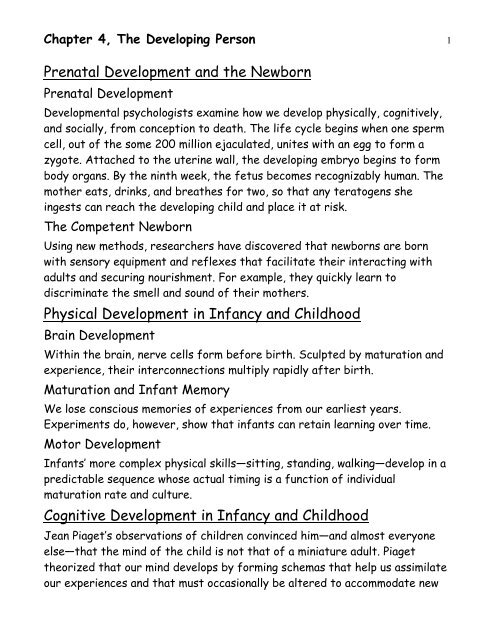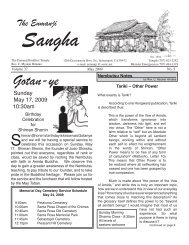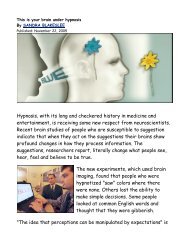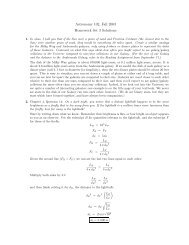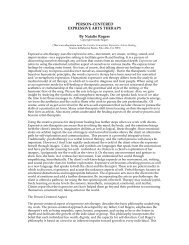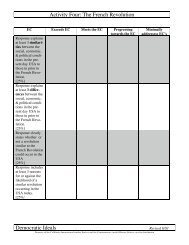Physical Development in Infancy and Childhood - Sonic.net
Physical Development in Infancy and Childhood - Sonic.net
Physical Development in Infancy and Childhood - Sonic.net
Create successful ePaper yourself
Turn your PDF publications into a flip-book with our unique Google optimized e-Paper software.
Chapter 4, The Develop<strong>in</strong>g Person 1<br />
Prenatal <strong>Development</strong> <strong>and</strong> the Newborn<br />
Prenatal <strong>Development</strong><br />
<strong>Development</strong>al psychologists exam<strong>in</strong>e how we develop physically, cognitively,<br />
<strong>and</strong> socially, from conception to death. The life cycle beg<strong>in</strong>s when one sperm<br />
cell, out of the some 200 million ejaculated, unites with an egg to form a<br />
zygote. Attached to the uter<strong>in</strong>e wall, the develop<strong>in</strong>g embryo beg<strong>in</strong>s to form<br />
body organs. By the n<strong>in</strong>th week, the fetus becomes recognizably human. The<br />
mother eats, dr<strong>in</strong>ks, <strong>and</strong> breathes for two, so that any teratogens she<br />
<strong>in</strong>gests can reach the develop<strong>in</strong>g child <strong>and</strong> place it at risk.<br />
The Competent Newborn<br />
Us<strong>in</strong>g new methods, researchers have discovered that newborns are born<br />
with sensory equipment <strong>and</strong> reflexes that facilitate their <strong>in</strong>teract<strong>in</strong>g with<br />
adults <strong>and</strong> secur<strong>in</strong>g nourishment. For example, they quickly learn to<br />
discrim<strong>in</strong>ate the smell <strong>and</strong> sound of their mothers.<br />
<strong>Physical</strong> <strong>Development</strong> <strong>in</strong> <strong>Infancy</strong> <strong>and</strong> <strong>Childhood</strong><br />
Bra<strong>in</strong> <strong>Development</strong><br />
With<strong>in</strong> the bra<strong>in</strong>, nerve cells form before birth. Sculpted by maturation <strong>and</strong><br />
experience, their <strong>in</strong>terconnections multiply rapidly after birth.<br />
Maturation <strong>and</strong> Infant Memory<br />
We lose conscious memories of experiences from our earliest years.<br />
Experiments do, however, show that <strong>in</strong>fants can reta<strong>in</strong> learn<strong>in</strong>g over time.<br />
Motor <strong>Development</strong><br />
Infants’ more complex physical skills—sitt<strong>in</strong>g, st<strong>and</strong><strong>in</strong>g, walk<strong>in</strong>g—develop <strong>in</strong> a<br />
predictable sequence whose actual tim<strong>in</strong>g is a function of <strong>in</strong>dividual<br />
maturation rate <strong>and</strong> culture.<br />
Cognitive <strong>Development</strong> <strong>in</strong> <strong>Infancy</strong> <strong>and</strong> <strong>Childhood</strong><br />
Jean Piaget’s observations of children conv<strong>in</strong>ced him—<strong>and</strong> almost everyone<br />
else—that the m<strong>in</strong>d of the child is not that of a m<strong>in</strong>iature adult. Piaget<br />
theorized that our m<strong>in</strong>d develops by form<strong>in</strong>g schemas that help us assimilate<br />
our experiences <strong>and</strong> that must occasionally be altered to accommodate new
Chapter 4, The Develop<strong>in</strong>g Person 2<br />
<strong>in</strong>formation. In this way, children progress from the simplicity of the<br />
sensorimotor stage <strong>in</strong> the first two years to more complex stages of<br />
th<strong>in</strong>k<strong>in</strong>g, which <strong>in</strong>clude a develop<strong>in</strong>g "theory of m<strong>in</strong>d."<br />
Piaget believed that preschool children, <strong>in</strong> the preoperational stage, are<br />
egocentric <strong>and</strong> unable to perform simple logical operations. At about age 6 or<br />
7 they enter the concrete operational stage <strong>and</strong> can perform concrete<br />
operations, such as those required to comprehend the pr<strong>in</strong>ciple of<br />
conservation. F<strong>in</strong>ally, at about age 12, children enter the formal operational<br />
stage, <strong>in</strong> which abstract reason<strong>in</strong>g is with<strong>in</strong> their grasp.<br />
Recent research <strong>in</strong>dicates that human cognition, regardless of culture, tends<br />
to unfold basically <strong>in</strong> the sequence Piaget proposed. However, young children<br />
are more capable, <strong>and</strong> development more cont<strong>in</strong>uous, than Piaget believed.<br />
The cognitive abilities that emerge at each stage apparently beg<strong>in</strong><br />
develop<strong>in</strong>g <strong>in</strong> a rudimentary form <strong>in</strong> the previous stage.<br />
Social <strong>Development</strong> <strong>in</strong> <strong>Infancy</strong> <strong>and</strong> <strong>Childhood</strong><br />
Orig<strong>in</strong>s <strong>and</strong> Effects of Attachment<br />
Attachment style <strong>in</strong> <strong>in</strong>fancy predicts later social development. Infants<br />
become attached to their mothers <strong>and</strong> fathers not simply because mothers<br />
<strong>and</strong> fathers gratify biological needs but, more importantly, because they are<br />
comfortable, familiar, <strong>and</strong> responsive. If denied such care, both monkey <strong>and</strong><br />
human <strong>in</strong>fants may become pathetically withdrawn, anxious, <strong>and</strong> eventually<br />
abusive. Once an attachment forms, <strong>in</strong>fants who are separated from their<br />
caregivers will, for a time, be distressed.<br />
Self-Concept <strong>and</strong> Child-Rear<strong>in</strong>g Practices<br />
As with cognitive abilities, a self-concept develops gradually. By 18 months,<br />
<strong>in</strong>fants recognize themselves <strong>in</strong> a mirror. By age 8 or 10, children’s selfimages<br />
are quite stable <strong>and</strong> are l<strong>in</strong>ked with their <strong>in</strong>dependence, optimism,<br />
<strong>and</strong> sociability. Children who develop a positive self-image <strong>and</strong> a happy, selfreliant<br />
manner tend to have been reared by parents who are neither<br />
permissive nor authoritarian, but authoritative while allow<strong>in</strong>g their children a<br />
sense of control. The parent<strong>in</strong>g-competence l<strong>in</strong>k is, however, correlational<br />
<strong>and</strong> does not expla<strong>in</strong> cause <strong>and</strong> effect.
Chapter 4, The Develop<strong>in</strong>g Person 3<br />
Adolescence<br />
<strong>Physical</strong> <strong>Development</strong><br />
Due to earlier maturation <strong>and</strong> prolonged education, adolescence—the<br />
transition years between biological maturity <strong>and</strong> social <strong>in</strong>dependence—has<br />
lengthened <strong>in</strong> many countries.<br />
Adolescence beg<strong>in</strong>s with a growth spurt that heralds the period of sexual<br />
maturation we call puberty <strong>and</strong> ends with the achievement of adult<br />
<strong>in</strong>dependence. Depend<strong>in</strong>g on how other people react, early or late maturation<br />
can <strong>in</strong>fluence adjustment, aga<strong>in</strong> illustrat<strong>in</strong>g how our genes <strong>and</strong> our<br />
environment <strong>in</strong>teract <strong>in</strong> shap<strong>in</strong>g us.<br />
Cognitive <strong>Development</strong><br />
Piaget theorized that adolescents develop the capacity for formal<br />
operations, which enables them to reason abstractly. Today’s<br />
developmentalists f<strong>in</strong>d the rudiments of formal logic appear<strong>in</strong>g earlier than<br />
Piaget believed.<br />
Follow<strong>in</strong>g Piaget’s lead, Lawrence Kohlberg contended that moral th<strong>in</strong>k<strong>in</strong>g<br />
likewise proceeds through a sequence of stages, from a preconventional<br />
morality of self-<strong>in</strong>terest, to a conventional morality concerned with ga<strong>in</strong><strong>in</strong>g<br />
others’ approval or do<strong>in</strong>g one’s duty, to (<strong>in</strong> some people) a postconventional<br />
morality of agreed-upon rights or universal ethical pr<strong>in</strong>ciples. But morality<br />
also lies <strong>in</strong> actions, which are <strong>in</strong>fluenced by the social situation <strong>and</strong> <strong>in</strong>ner<br />
attitudes as well as by moral reason<strong>in</strong>g. Moreover, say Kohlberg’s critics, the<br />
postconventional level represents morality from the perspective of<br />
<strong>in</strong>dividualist, liberal-m<strong>in</strong>ded males. The social <strong>in</strong>tuitionist perspective on<br />
morality suggests that moral feel<strong>in</strong>gs may precede moral judgments <strong>and</strong><br />
<strong>in</strong>fluence our actions.<br />
Social <strong>Development</strong><br />
Erik Erikson theorized that a chief task of adolescence is solidify<strong>in</strong>g one’s<br />
sense of self—one’s identity. For many people, this struggle cont<strong>in</strong>ues <strong>in</strong>to<br />
the adult years as new relationships emerge <strong>and</strong> new roles are assumed.<br />
Although adolescence has traditionally been viewed as a time of storm <strong>and</strong><br />
stress, researchers have found that most teenagers relate to their parents
Chapter 4, The Develop<strong>in</strong>g Person 4<br />
reasonably well <strong>and</strong> generally affirm their parents’ beliefs <strong>and</strong> attitudes.<br />
Gender differences <strong>in</strong> connectedness <strong>and</strong> other traits tend to peak dur<strong>in</strong>g<br />
late adolescence <strong>and</strong> early adulthood.<br />
Adulthood<br />
Dur<strong>in</strong>g early life, we sail a narrow channel, constra<strong>in</strong>ed by biological<br />
maturation. As the years pass, the channel widens, allow<strong>in</strong>g us to diverge<br />
more <strong>and</strong> more. By adulthood, age no longer neatly predicts a person’s life<br />
experience <strong>and</strong> traits. Yet <strong>in</strong> some ways our bodies, m<strong>in</strong>ds, <strong>and</strong> relationships<br />
still undergo predictable changes. As long as we live, we adapt.<br />
<strong>Physical</strong> <strong>Development</strong><br />
The barely perceptible physical decl<strong>in</strong>es of early adulthood beg<strong>in</strong> to<br />
accelerate dur<strong>in</strong>g middle adulthood. For women, a significant physical change<br />
is menopause, which generally seems to be a smooth rather than rough<br />
transition. For both men <strong>and</strong> women perceptual acuity, strength, <strong>and</strong> stam<strong>in</strong>a<br />
decl<strong>in</strong>e after 65, but short-term ailments are fewer. Neural processes slow,<br />
<strong>and</strong> except for those who suffer bra<strong>in</strong> disease, such as the progressive<br />
deterioration of Alzheimer’s disease, the bra<strong>in</strong> rema<strong>in</strong>s healthy.<br />
Cognitive <strong>Development</strong><br />
As the years pass, recognition memory rema<strong>in</strong>s strong, although recall beg<strong>in</strong>s<br />
to decl<strong>in</strong>e, especially for mean<strong>in</strong>gless <strong>in</strong>formation. Research on how<br />
<strong>in</strong>telligence changes with age has progressed through several phases: crosssectional<br />
studies suggest<strong>in</strong>g a steady <strong>in</strong>tellectual decl<strong>in</strong>e after early<br />
adulthood; longitud<strong>in</strong>al studies suggest<strong>in</strong>g <strong>in</strong>tellectual stability until very late<br />
<strong>in</strong> life; <strong>and</strong> today’s view that fluid <strong>in</strong>telligence decl<strong>in</strong>es <strong>in</strong> later life, but<br />
crystallized <strong>in</strong>telligence does not.<br />
Social <strong>Development</strong><br />
From close study of small samples of <strong>in</strong>dividuals, some theorists ma<strong>in</strong>ta<strong>in</strong><br />
that adults pass through an orderly sequence of life stages. Some theorists<br />
have contended that mov<strong>in</strong>g from one stage to the next entails recurr<strong>in</strong>g<br />
times of crisis, such as the transition to midlife dur<strong>in</strong>g the early forties. But<br />
people are not so predictable. Adult life is <strong>in</strong>fluenced <strong>in</strong> unanticipated ways,<br />
not only by events <strong>in</strong>volv<strong>in</strong>g love <strong>and</strong> work but also by chance occurrences.
Chapter 4, The Develop<strong>in</strong>g Person 5<br />
S<strong>in</strong>ce 1960, marriage has been <strong>in</strong> decl<strong>in</strong>e, as reflected <strong>in</strong> later marriages,<br />
<strong>in</strong>creased cohabitation, <strong>and</strong> doubled divorce rates.<br />
Although few people grow old gratefully, most age gracefully, reta<strong>in</strong><strong>in</strong>g a<br />
sense of well-be<strong>in</strong>g throughout life. Those who live to old age must, however,<br />
cope with the deaths of friends <strong>and</strong> family members <strong>and</strong> with the prospect<br />
of their own deaths. Our experience with death is <strong>in</strong>fluenced by our<br />
experiences <strong>in</strong> life.<br />
Reflections on Two Major <strong>Development</strong>al Issues<br />
We have touched on two of developmental psychology’s pervasive issues:<br />
cont<strong>in</strong>uity <strong>and</strong> discrete stages, <strong>and</strong> stability <strong>and</strong> change <strong>in</strong> personality.<br />
Although the stage theories of Piaget, Kohlberg, <strong>and</strong> Erikson have been<br />
modified <strong>in</strong> light of later research, each theory usefully alerts us to<br />
differences among people of different ages <strong>and</strong> helps us keep the life-span<br />
perspective <strong>in</strong> view. Research f<strong>in</strong>d<strong>in</strong>gs that reveal how people’s traits<br />
cont<strong>in</strong>ue to change <strong>in</strong> later life have helped create a new emphasis on lifelong<br />
development. Nevertheless, there is also an underly<strong>in</strong>g consistency to most<br />
people’s temperaments <strong>and</strong> personality traits.


